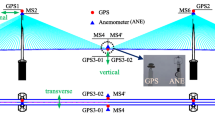Abstract
Although the structural health monitoring (SHM) based on the displacement measurement has been adopted in some cases of long-span bridges and recognized several advantages, there are some issues required to be considered, such as in acquiring the long-term static displacements with high and stable accuracies and in converting large amount of data into usable information. The global positioning system (GPS) is expected to solve those issues. This study aims to analyze the GPS time-series data acquired in a cable-stayed bridge in Vietnam, and to verify the usable feature for the structural condition assessment. Here, we suggest the use of the global deformations that are due to the periodic air temperature changes. Firstly, we observed the quality of acquired GPS data, and the missing data was interpolated by applying the least-squares estimation. The correlation coefficient analysis was then conducted using both the GPS and the air temperature data to understand the global deformation due to temperature changes. It was clarified that the global towers-girder coupled deformation was dominated by the 1-day periodic temperature change. The autoregressive integrated moving average (ARIMA) model was then applied to the GPS time-series data, and it was shown that there were high regressions in some AR-MA coefficients plots. It was thus concluded that those plots could be used as the base distributions for the statistical structural condition assessment.









Similar content being viewed by others
References
Kaloop MR, Li H (2009) Monitoring of bridge deformation using GPS technique. KSCE J Civil Eng 13(6):423–431
Kaloop MR, Li H (2011) Sensitivity and analysis GPS signals based bridge damage using GPS observations and wavelet transform. Measurement 44(5):927–937
Celebi M (2000) GPS in dynamic monitoring of long-period structures. Soil Dyn Earthq Eng 20(5):477–483
Cheng P, John W, Zheng W (2002) Large structure health dynamic monitoring using GPS technology. In: FIG XXII International Congress, Washington DC
Fujino Y, Murata M, Okano S, Takeguchi M (2000) Monitoring system of the Akashi Kaikyo Bridge and displacement measurement using GPS. In: SPIE’s 5th Annual International Symposium on Nondestructive Evaluation and Health Monitoring of Aging Infrastructure. International Society for Optics and Photonics, pp 229–236
Sohn H, Dzwonczyk M, Straser EG, Kiremidjian AS, Law KH, Meng T (1999) An experimental study of temperature effect on modal parameters of the Alamosa Canyon bridge. Earthq Eng Struct Dyn 28(8):879–897
Cornwell P, Farrar CR, Doebling SW, Sohn H (1999) Environmental variability of modal properties. Exp Tech 23(6):45–48
Farrar CR, Cornwell P, Doebling SW, Prime MB (2000). Structural health monitoring studies of the Alamosa Canyon and I-40 bridges. Los Alamos National Laboratory, LA-13635-MS
Omenzetter P, Brownjohn JMW (2005) A seasonal ARIMAX time series model for strain-temperature relationship in an instrumented bridge. Proceedings of the 5th International Workshop on Structural Health Monitoring, pp 299–306
Omenzetter P, Brownjohn JMW (2006) Application of time series analysis for bridge monitoring. Smart Mater Struct 15(1):129–138
Sohn H, Czarnecki JA, Farrar CR (2000) Structural health monitoring using statistical process control. J Struct Eng 126(11):1356–1363
Pigott TD (2001) A review of methods for missing data. Educ Res Eval 7(4):353–383
Gerald CF, Wheatley PO (2004) Applied numerical analysis. 7th edn, chapter 3, pp 203–207
Shumway RH, Stoffer DS (2010) Time series analysis and its applications: with R examples. Springer
Hirose K, Kawano S, Konishi S, Ichikawa M (2011) Bayesian information criterion and selection of the number of factors in factor analysis models. J Data Sci 9(2):243–259
Author information
Authors and Affiliations
Corresponding author
Rights and permissions
About this article
Cite this article
Van Le, H., Nishio, M. Time-series analysis of GPS monitoring data from a long-span bridge considering the global deformation due to air temperature changes. J Civil Struct Health Monit 5, 415–425 (2015). https://doi.org/10.1007/s13349-015-0124-9
Received:
Revised:
Accepted:
Published:
Issue Date:
DOI: https://doi.org/10.1007/s13349-015-0124-9




